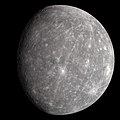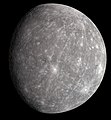Bhengkek:Mercury in true color.jpg

Okoran tèngghu kadâ' arèya: 600 × 600 piksel. Rèsolusi laèn: 240 × 240 piksel | 480 × 480 piksel | 768 × 768 piksel | 1.040 × 1.040 piksel.
Bhengkek sokkla (1.040 × 1.040 piksel, okoran bhengkek: 408 KB, lambân MIME: image/jpeg)
Riwayât bhengkek
Klik è tangghâl/bâkto mon nèngghuwâ bhengkek arèya ka bâjâ kasebbhut.
| Tangghâl/Bâkto | Miniatur | Ḍimènsi | Pangangghuy | Komèntar | |
|---|---|---|---|---|---|
| jângkènè | 15 Mèi 2023 15.16 |  | 1.040 × 1.040 (408 KB) | CactiStaccingCrane | Reverted to version as of 10:42, 24 July 2022 (UTC) |
| 15 Mèi 2023 15.01 |  | 1.024 × 1.024 (837 KB) | CactiStaccingCrane | Manually merge the original monochrome image with the calibrated color image to eek out more resolution | |
| 24 Juli 2022 17.42 |  | 1.040 × 1.040 (408 KB) | JCP-JohnCarlo | Make this planet image center | |
| 24 Juli 2022 17.25 |  | 1.040 × 1.040 (710 KB) | JCP-JohnCarlo | Canvas image | |
| 3 Novèmber 2019 16.00 |  | 960 × 1.040 (865 KB) | Mirecki | User created page with UploadWizard |
Pangangghuyân bhengkek
Taḍâ' kaca sè ngangghuy bhengkek arèya.
Pangangghuyân bhengkek global
Wiki sè laèn ngangghuy bhengkek arèya:
- Pangangghuyân ka af.wikipedia.org
- Pangangghuyân ka als.wikipedia.org
- Pangangghuyân ka ar.wikibooks.org
- Pangangghuyân ka as.wikipedia.org
- Pangangghuyân ka be-tarask.wikipedia.org
- Pangangghuyân ka beta.wikiversity.org
- Pangangghuyân ka bn.wikibooks.org
- Pangangghuyân ka bo.wikipedia.org
- Pangangghuyân ka br.wikipedia.org
- Pangangghuyân ka ceb.wikipedia.org
- Pangangghuyân ka ckb.wiktionary.org
- Pangangghuyân ka csb.wikipedia.org
- Pangangghuyân ka cv.wikipedia.org
- Pangangghuyân ka cy.wikipedia.org
- Pangangghuyân ka de.wikipedia.org
- Pangangghuyân ka dty.wikipedia.org
- Pangangghuyân ka dz.wikipedia.org
- Pangangghuyân ka eml.wikipedia.org
- Pangangghuyân ka en.wikipedia.org
- Mercury (planet)
- Terrestrial planet
- The Planets
- Timeline of discovery of Solar System planets and their moons
- List of Solar System objects by size
- List of gravitationally rounded objects of the Solar System
- User:Kwamikagami/sandbox
- NASA
- User:Kazkaskazkasako/Books/Physical sciences
- Talk:Mercury (planet)/Archive 3
- User:Nrco0e/Userboxes
- User:Applekle/sandbox
- Wikipedia:Userboxes/Location/Extraterrestrial
- Talk:The Planets/GA1
- User:Double sharp/Largest Solar System objects
- User:TomMasterReal
- User:Nrco0e/Userboxes/FavMercury
- User:KeroseneLover100/sandbox/sandbox
- Pangangghuyân ka en.wikibooks.org
- Pangangghuyân ka en.wiktionary.org
- Pangangghuyân ka eo.wikipedia.org
- Pangangghuyân ka es.wikipedia.org
Tèngghu lebbi bânnya' pangangghuy global dâri bhengkek rèya.


